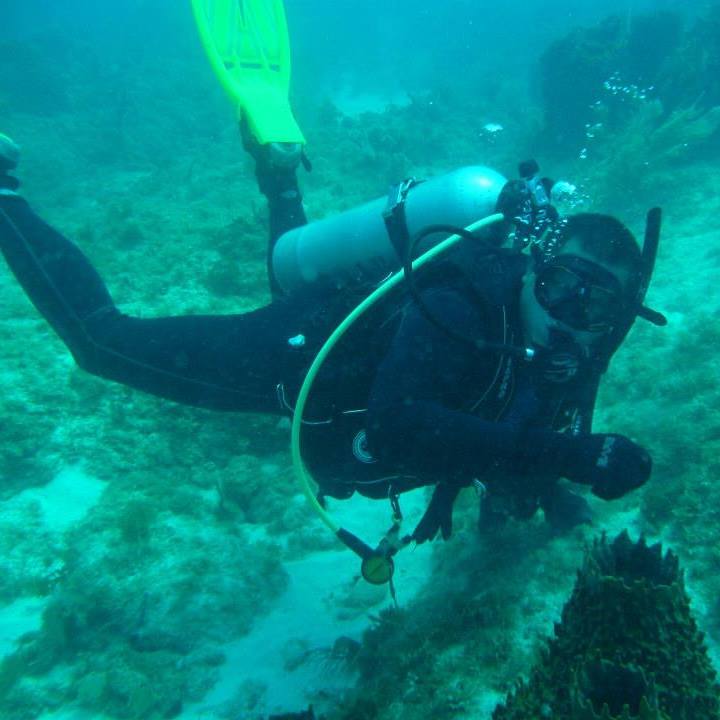Some time ago we asked, “Where will history take you?” In our map in Williams Hall, students and faculty have marked tens of places in four continents. This post, by Mike Horton, a History M.A. student, shows us how sometimes history takes us well beyond the beaten path.
 Over the course of this semester I have been involved in developing a historical narrative for the production of a television show. Titled “Pirates & Privateers The Quest For The Mother Lode,” the show is set to premiere on the Discovery Channel in 2017. I became involved in this project through a chance meeting with the show’s producer over the summer and learned that they’re searching for lost Spanish shipwrecks in the Caribbean dating back to the 17th century. This show was sparked by the desire to tell the story of the 1985 discovery of the Nuestra Senora de Atocha and the Santa Margarita. These two ships were part of a Spanish treasure fleet which sank in 1622 during a fierce hurricane. The two ships were discovered off the coast of Key West, and the show begins by telling this story before launching the topic of lost wrecks.
Over the course of this semester I have been involved in developing a historical narrative for the production of a television show. Titled “Pirates & Privateers The Quest For The Mother Lode,” the show is set to premiere on the Discovery Channel in 2017. I became involved in this project through a chance meeting with the show’s producer over the summer and learned that they’re searching for lost Spanish shipwrecks in the Caribbean dating back to the 17th century. This show was sparked by the desire to tell the story of the 1985 discovery of the Nuestra Senora de Atocha and the Santa Margarita. These two ships were part of a Spanish treasure fleet which sank in 1622 during a fierce hurricane. The two ships were discovered off the coast of Key West, and the show begins by telling this story before launching the topic of lost wrecks.
 The work being conducted for this show combines two of the greatest passions in my life: history and scuba diving. During the course of my graduate studies, European colonization of the Americas has become a focus of my research, so this show peaked my interest immediately. I am also an avid scuba diver; I’ve been been diving for nearly twelve years now, earned my instructor certification and spent a year teaching people to dive in the Florida Keys.
The work being conducted for this show combines two of the greatest passions in my life: history and scuba diving. During the course of my graduate studies, European colonization of the Americas has become a focus of my research, so this show peaked my interest immediately. I am also an avid scuba diver; I’ve been been diving for nearly twelve years now, earned my instructor certification and spent a year teaching people to dive in the Florida Keys.
The combination of these two passions led me to become a part of this show. It has been my job to create a general outline narrative explaining the rise of the Spanish empire in the Americas in order to set the stage for 17th century life in the Caribbean. During the rise of the Spanish empire, the stretch of ocean between the Florida Keys and the Bahamas became the main travel route for ships to and from the Caribbean. Thousands of ships traveled this route and those that have sunk now litter the ocean floor. This area has been the principal location for my research: its history and prime location for the search for shipwrecks. I have also been involved in the research of other potential shipwreck locations and developing the backstory of famous shipwrecks throughout the Caribbean. Conducting this research has been a rewarding experience and I have really enjoyed it. Ever since my chance meeting back in May, I have wanted to get out there on the water and dive in search of these lost wrecks. In December, I’ll finally have my chance, when we travel to the Bahamas to investigate three potential shipwreck locations. Our goal is to locate and identify these wrecks as well as recover any cargo that might have survived. During this expedition we will record our search and develop the story of these wrecks to inform viewers why these ships are here and possibly discover how they were lost.
Written by Mike Horton. Mike is a History M.A. student and an alum of our undergraduate program, who is writing a thesis on Christopher Columbus and intends to pursue a PhD in history.
